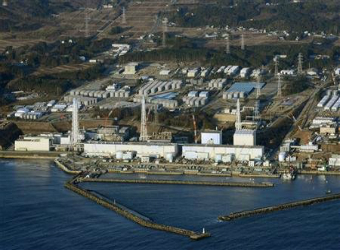Workers at Japan’s crippled Fukushima nuclear plant on Thursday scrambled to check 300 tanks storing highly radioactive water, after one sprang a leak that is feared to have seeped into the Pacific.
Some 300 tonnes of toxic liquid was believed to have escaped from one of the tanks that hold water used to cool the broken reactors, while operator Tokyo Electric Power Co (TEPCO) warned some of it might have flowed into the ocean.
“We are hurriedly checking if some 300 tanks of the same type holding contaminated water have the same leak problem,” a TEPCO spokesman said.
“We have finished pumping out water from the troubled tank, while we have continued removing the soil soaked by the water,” he said.
Spokesman Tsuyoshi Numajiri said Wednesday that traces of radioactivity were detected in a drainage stream.
“We cannot rule out the possibility that part of the contaminated water flowed into the sea,” he said.
On Wednesday, nuclear regulators said the leak represented a level-three “serious incident” on the UN’s seven-point International Nuclear Event Scale (INES), which measures radiation accidents.
The alert was raised from level one, which indicates an “anomaly”.
It is the most serious single event since the plant was declared to be in a “state of cold shutdown” — effectively indicating it was under control at the end of 2011.
The quake and tsunami-sparked meltdowns at the plant in March of that year were ultimately declared to be level seven on the INES scale. The Chernobyl disaster in 1986 is the only other incident to have been given the most serious ranking.
TEPCO has said puddles of water near the tank were so toxic that anyone exposed to them would receive the same amount of radiation in an hour that a nuclear plant worker in Japan is allowed to receive in five years.
The utility did not have a water-level gauge on the 1,000-tonne tank, which experts say would have made it a lot more difficult to detect the problem.
Thursday’s safety checks on 300 tanks came after Nuclear Regulation Authority (NRA) chairman Shunichi Tanaka on Wednesday voiced concern that there could be similar leaks from other containers.
“We must carefully deal with the problem on the assumption that if one tank springs a leak the same thing can happen at other tanks,” he said.
The company — which faces huge clean-up and compensation costs — has struggled to cope with the disaster.
More than two years after the meltdowns, it continues to be beset by difficulties, chief among which is how it should handle the vast amounts of water used to cool the broken reactors.
Around 1,000 tanks of varying sizes have been installed at the site to contain it, but experts warn this can only be a temporary fix.
A series of problems, and delays in announcing them to the public, have added to the impression that the huge utility is not on top of the clean-up.
TEPCO in July admitted for the first time that radioactive groundwater had been leaking outside the plant.
This month it started pumping it out to reduce leakage into the Pacific.
The problems have led the Japanese government and the NRA to say they would become more directly involved in the operation at Fukushima.
While no one is officially recorded as having died as a direct result of the radiation released by the meltdowns, large areas around the plant had to be evacuated.
Tens of thousands of people are still unable to return to their homes, with scientists warning some areas may have to be abandoned.
Source: AFP


